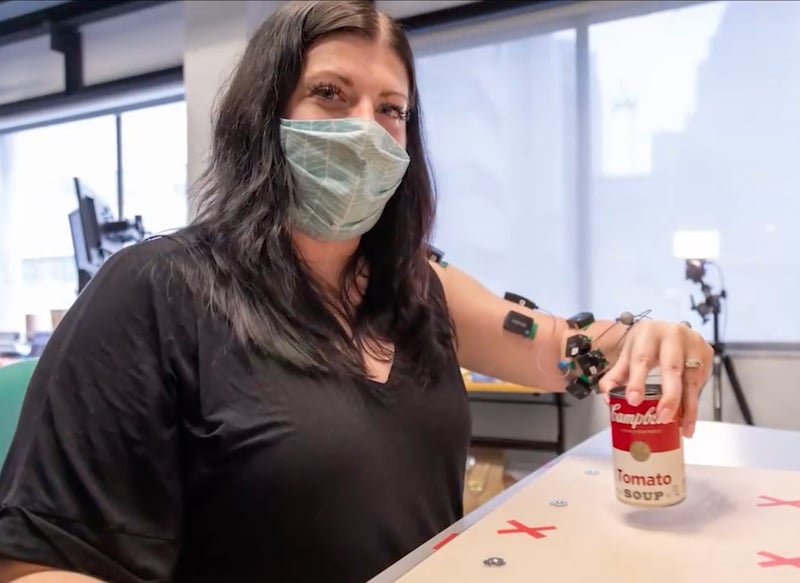Get Healthy!

- Alan Mozes
- Posted February 20, 2023
Spinal Cord Stimulation Gives Big Boost to Arm Function After Stroke
It's a brutal reality that confronts many recovering stroke patients: After six months or so of rehab, any arm and hand movement not yet restored is unlikely to return.
But new cutting-edge research aims to use electrical stimulation to jumpstart stroke-interrupted communication between the brain and the spinal cord, restoring lost motor control. The technique is already widely used as a treatment for chronic pain.
Preliminary testing in patients who have had moderate to severe strokes suggests it can return significant arm and hand function to patients who, in some cases, haven't had any upper limb control in years.
"Most of the time [stroke patients] get physical therapy, improve a little bit, and then remain with permanent deficits which are considered chronic,"said study author Marco Capogrosso, an assistant professor of neurological surgery at the University of Pittsburgh.
For such patients, "no additional therapy seems to be beneficial,"he said.
Capogrosso and his colleagues spoke about their work at a news briefing Feb. 15, ahead of publication of their research in the current issue of Nature Medicine.
Stroke is the largest cause of paralysis in the world, Capogrosso said at the briefing. In the United States alone, he noted, roughly half of the 800,000 Americans who experience a stroke each year are left "with permanent motor deficits."
But Capogrosso and his colleagues saw potential for a therapeutic breakthrough. That's because even though stroke often weakens communication between the brain and the spinal cord, it is not cut off completely.
With that in mind, the researchers set out to use electrical stimulation in order to "leverage and amplify"the stroke-diminished signaling, he said.
Initial testing focused on two patients with chronic loss of hand and arm movement: a 31-year-old woman who suffered five strokes at the age of 22, and a 47-year-old woman.
Each was outfitted with an array of thin electrode wires that "kind of look like a spaghetti noodle,"said study author Douglas Weber, a professor of mechanical engineering at Carnegie Mellon University, in Pittsburgh.
In what Weber described as a "minimally invasive"process, the electrodes were inserted by needle into each patient's back, and placed "at the point where the sensory nerves from the limb enter the spinal cord."
Then, for a couple of hours a day, five days a week over one month investigators delivered a series of controlled but continuous electric pulses into targeted nerve cells in each patient's spinal cord, said co-author Elvira Pirondini of Rehab Neural Engineering Labs at the University of Pittsburgh.
Capogrosso, Weber and Pirondini said the stimulation technique produced almost immediate improvements in both arm and hand strength and function.
For example, Capogrosso said both patients were newly able to do previously difficult tasks, such as opening a lock, eating with utensils, or grasping and holding objects.
In the case of 31-year-old Heather Rendulic "” who had lost control of one of her hands after her initial stroke -- such tasks had been impossible for nearly a decade.
"When the stimulation is on, I feel like I now have control of my arm and my hand again, that I haven't had in over nine years,"she said in a demonstration video released by the study team:
Rendulic described the results as "awesome,"adding that stimulation feels "kind of like a tickle"but is never painful.
"These are incredible results, that have never been shown with other technologies,"Pirondini said, adding that no training was necessary.
"This technology is actually leveraging the natural way that we have to move,"she said.
"Immediately, from day one, patients could already perform some movement,"Pirondini added.
Capogrosso emphasized that each patient was able to "voluntarily control their own limbs."
"This is not passively moving the limb,"he noted. "We're not bypassing their control. We're enhancing their capabilities to move their own arms."
Over time, each patient's movement control got "better and better,"Capogrosso said, increasing the number of tasks they could perform.
And, unexpectedly, some stimulation-triggered movement continued even after the electrical pulses were stopped, "as if the brain somehow learned to control again the arm even when the stimulation was off,"he added.
So while the stimulation is designed to be always "on,"the findings seem to suggest that the brain is somehow able to quickly and smoothly integrate external electric signals into the process of moving muscles, Capogrosso said. He characterized that finding as both "surprising"and "fascinating."
More research with a bigger pool of patients is needed to better understand how the integration process actually unfolds, and to figure out which stroke patients stand to gain the most from the procedure, Capogrosso noted.
More information
Learn more about strokes at Johns Hopkins Medicine.
SOURCES: Marco Capogrosso, PhD, assistant professor, neurological surgery, University of Pittsburgh, Pa.; Elvira Pirondini, PhD, assistant professor, Rehab Neural Engineering Labs, University of Pittsburgh, Pa.; Douglas Weber, PhD, professor, mechanical engineering, Carnegie Mellon University, Pittsburgh, Pa.; Heather Rendulic, stroke patient, Faith Not Fear LLC, Pittsburgh, Pa.; Nature Medicine, Feb. 20, 2023







